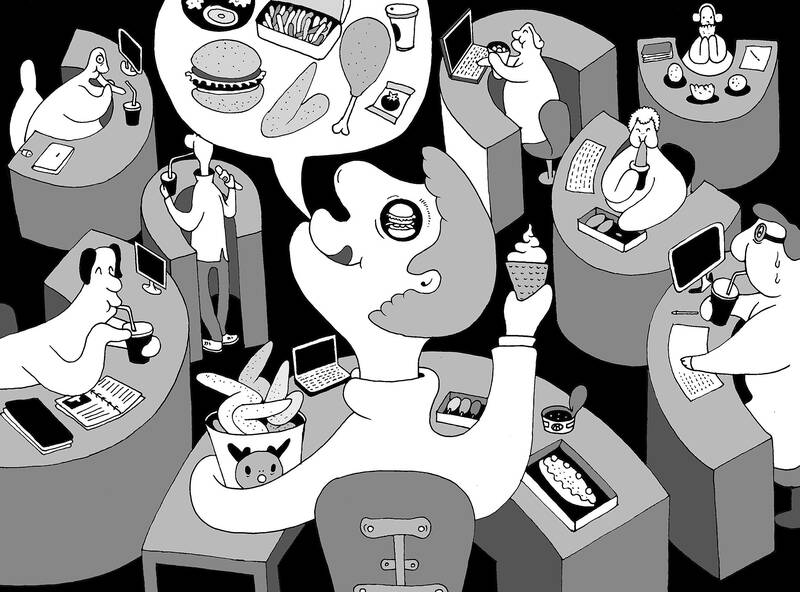We live in a toxic food environment, and Big Food has extremely clever marketers and food scientists. That all of us eat a lot of Big Food’s produce means those people are very good at their jobs. It does not mean we have failed if we eat what the industry makes.
In the UK, about 50 percent of the average adult’s diet and 65 percent of a child’s is ultra-processed.
As Chris van Tulleken wrote in his latest book — Ultra-Processed People: Why Do We All Eat Stuff That Isn’t Food and Why Can’t We Stop? — a lot of what we eat includes newly invented substances that humans have not eaten before and we know very little about how they interact with us or each other.

Illustration: Mountain People
Such foods are likely to be made by companies such as Unilever, PepsiCo or Nestle. The UK food industry spends £1.14 billion (US$1.42 billion) a year on advertising and, as ex-Big Food marketer Dan Parker has said, it uses manipulative tactics such as associating foods such as chocolate with positive things like relaxation (KitKats, Maltesers) or emotional openness (Cadbury’s “Give A Doubt”), while normalizing over-consumption with ads showing one — always small — person eating a family-size bar (think Audrey Hepburn in the Galaxy advert).
Criticizing ultra-processed foods (UPFs) is not necessarily the same as shaming those who eat them, but we do shame and blame people who eat UPFs, including, often, ourselves, and that should stop.
We also have a nasty habit of demonizing foods that are important to specific cultures, such as fried chicken.
Shame is never motivating and what we eat is not a cipher for morality. Although almost all of us eat a lot of UPFs, we tend to think of it as a problem that mainly affects people who live in poverty. It is absolutely not constructive to vilify the diets of people already living in highly stressful situations, but it is also a mistake to assume this does not affect “us,” whatever your socioeconomic position might be.
Arranging society so people do not feel they have enough time or money to make themselves a meal is a dystopian nightmare that UPFs hide in plain sight. Definitions vary, but they mainly come in a packet and are made with preservatives, stabilizers, emulsifiers and colors or flavor enhancers. They include everyday items such as shop-bought hummus, stuffed pasta, hot sauce, curry paste, ready meals, some jams, most peanut butters, most breads, vegan meat alternatives, almost all cereals, most cured meats, burgers and sausages, soft drinks, sweetened or low-fat yoghurts, many “free from” products, dairy replacements, and almost all the ice-creams, desserts and cookies in the supermarket. If your trolley does not contain a fair chunk of that list, then there are few possibilities: You have superhuman levels of willpower; you are very wealthy and/or have your own from-scratch cook; you are lying.
Many UPFs are cheap, but those that are not often come branded with a health halo, as with plant-based meat alternatives, cereal bars or protein powders. In reality, consumption of UPFs of all types is associated with an increased risk of all sorts of health issues, including cancers and weight gain.
UPFs are convenient and are carefully marketed as a way to make our busy-busy lives easier. Those who criticize UPFs are therefore often seen as having a go at people who already feel harried by the way we have arranged society, but the problem is not with us. The problem is structural.
Arranging society so that people do not feel that they have enough time or money to make themselves a meal is a dystopian nightmare. Selling us cheap food that might harm us, but is framed as being helpful or healthy, is a dystopian nightmare. And, as Henry Dimbleby said in his new book, Ravenous, so is urban planning, which means more than 3 million people cannot access shops that sell fresh produce.
Our hysterical fear of fatness has led us to individualize responsibility for what we eat, while also failing to take account of the highly nuanced relationship between body size and health. Even though 59 types of obesity have been identified, the UK’s (noticeably unsuccessful) approach to weight management is still variations on the theme of eat less, exercise more, plus the new and wildly hyped semaglutide weight-loss drugs, Ozempic and Wegovy (originally created to treat diabetes), about which media from The Economist to New York Magazine have gushed (often containing a throwaway line about gastric side effects, and the associated risk of pancreatitis and possibly cancer).
These are trying to solve the wrong problem: We should not be living in a food environment in which a sizeable number of people need (or want) to be drugged to cope with it.
The popularity of UPFs is symptomatic of something much bigger, and not just that Big Food is great at marketing and making irresistible, energy-dense foods. It is about the primacy of work, long hours, low pay, hustle culture, structural inequalities, poverty and precarity. For most of us, it is almost impossible to make so-called “good” food choices.
This is particularly the case if you are stressed, exhausted or laboring under any kind of scarcity or insecurity, all of which have been shown in many studies to affect not just our food choices, but also how our bodies metabolize food.
And who is not feeling the pressure of living in perma-crisis Britain, to some extent?
Solving the problem is not about manufacturers changing formulations (although that might help). It is much harder than that. Our problems with food are just symptoms of other social problems, which is why it is ridiculous to pretend that any of us, individually, can solve them.
If there is a moral question to be answered, it is by those who make UPFs, not those who eat them.
Every time we make an individual body — ours, or someone else’s — the site for a conversation about “good” and “bad” food choices, weight or shape, we look at the problem upside down. We make our food choices into a moral maze instead of saying: “It is food that is broken and needs to change. Not us.”
Rebecca Seal is a freelance writer and editor.

On Sept. 3 in Tiananmen Square, the Chinese Communist Party (CCP) and the People’s Liberation Army (PLA) rolled out a parade of new weapons in PLA service that threaten Taiwan — some of that Taiwan is addressing with added and new military investments and some of which it cannot, having to rely on the initiative of allies like the United States. The CCP’s goal of replacing US leadership on the global stage was advanced by the military parade, but also by China hosting in Tianjin an August 31-Sept. 1 summit of the Shanghai Cooperation Organization (SCO), which since 2001 has specialized
In an article published by the Harvard Kennedy School, renowned historian of modern China Rana Mitter used a structured question-and-answer format to deepen the understanding of the relationship between Taiwan and China. Mitter highlights the differences between the repressive and authoritarian People’s Republic of China and the vibrant democracy that exists in Taiwan, saying that Taiwan and China “have had an interconnected relationship that has been both close and contentious at times.” However, his description of the history — before and after 1945 — contains significant flaws. First, he writes that “Taiwan was always broadly regarded by the imperial dynasties of
The Chinese Communist Party (CCP) will stop at nothing to weaken Taiwan’s sovereignty, going as far as to create complete falsehoods. That the People’s Republic of China (PRC) has never ruled Taiwan is an objective fact. To refute this, Beijing has tried to assert “jurisdiction” over Taiwan, pointing to its military exercises around the nation as “proof.” That is an outright lie: If the PRC had jurisdiction over Taiwan, it could simply have issued decrees. Instead, it needs to perform a show of force around the nation to demonstrate its fantasy. Its actions prove the exact opposite of its assertions. A
A large part of the discourse about Taiwan as a sovereign, independent nation has centered on conventions of international law and international agreements between outside powers — such as between the US, UK, Russia, the Republic of China (ROC) and Japan at the end of World War II, and between the US and the People’s Republic of China (PRC) since recognition of the PRC as the sole representative of China at the UN. Internationally, the narrative on the PRC and Taiwan has changed considerably since the days of the first term of former president Chen Shui-bian (陳水扁) of the Democratic